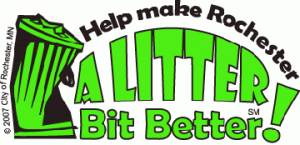Your City can be a Litter Bit Better Too
The Goal of A Litter Bit Better
More and more people picking up less and less litter every year.
Why A Litter Bit Better Works
The steering committee is a cooperative effort between individuals, businesses, non-profit organizations, and the local government. A litter-free city benefits all parts of the community. The steering committee is a group of highly dedicated people who are passionate about the mission.
The event runs for a whole week, allowing volunteer groups to schedule a pickup at their convenience. This also allows for rescheduling due to weather conditions.
Volunteers sign up for a few hours of service, not recurring duties.
Coordination of signup, bag distribution, and hauling is easy. Groups do not need to dispose of the litter that they collect.
The event has almost no opposition, as the concept is hard to criticize. It is a win-win.
The community, and especially the volunteers, become aware of the littering problem and change some behavior.
How A Litter Bit Better Works
Volunteer group leaders go to the event website and select an area to pick up from an online map.
The group leader calls the event coordinator, who carries a dedicated cell phone for the duration of the event, and reserves the area. The registration includes area, time, # of volunteers, and contact information.
The event coordinator emails the group leader an information packet with instructions, safety guidelines, and a volunteer waiver.
The group obtains free green trash bags and blue recyclable bags from an area convenience store chain that participates in the event. The many locations of this chain allow efficient distribution.
The group picks up their area, stacks the bags in an accessible spot, and calls the event coordinator to confirm the amount and location of the collected litter.
The event coordinator arranges bag collection with a local construction company that volunteers its trucks during the event.
The collected litter is hauled to the waste hauler’s site and is weighed and accumulated into a “trash mountain”. The trash mountain is good for photo ops.
A Timeline for How A Litter Bit Better Developed Into a Successful Annual Project
January 15, 2007
Somebody decided to do something about littering and enlisted a friend.
The two friends prototyped a brochure for a “Community Litter Pickup Day” and pitched their idea to a contact in the chamber of commerce for feedback and suggestions.
Through assistance from the chamber of commerce, the friends scheduled a brief meeting with the Mayor and presented their idea and the prototype.
The Mayor liked the idea and suggested a steering committee be created with representatives from the media, Dept of Public Works, area environmental groups, neighborhood associations, the business community, and youth associations such as the Boy & Girl Scouts.
February 7, 2007
The steering committee convened and within two months had revised the “Community Litter Pickup Day” into a one-week “Litter Bit Better” project.
The City Department of Public Works contributed a staff person for 6 weeks to coordinate the project. All steering committee members and groups also volunteered time for designing, planning, promoting, and organizing the event.
March, 2008
A local waste hauler volunteered to haul and dispose collected litter.
Local radio, television, and newspaper media sponsored public service announcements to promote the event.
The steering committee secured contributions from businesses, individuals, and a community foundation to fund garbage bags, supplies, printing, and some advertising. The waste hauler covered the disposal costs, and the media provided coverage and public service announcements.
Other promotional activities included posters, letters to groups, clubs, neighborhoods, churches, and other organizations.
April 21-28, 2007
1,374 volunteers picked up 10 tons of litter from 161 designated areas within Rochester.
April 19-26, 2008
Prior year experience allowed more efficient planning and coordination. The same event in 2008 resulted in 4,000 volunteers picking up 12 tons of litter. Key factors were extensive media coverage and involvement by neighborhoods and student groups who obtained community service hours for sports teams and clubs.
